[English] 日本語
 Yorodumi
Yorodumi- PDB-7s5t: Human KATP channel in open conformation, focused on Kir (C166S G3... -
+ Open data
Open data
- Basic information
Basic information
| Entry | Database: PDB / ID: 7s5t | ||||||||||||||||||||||||||||||||||||
|---|---|---|---|---|---|---|---|---|---|---|---|---|---|---|---|---|---|---|---|---|---|---|---|---|---|---|---|---|---|---|---|---|---|---|---|---|---|
| Title | Human KATP channel in open conformation, focused on Kir (C166S G334D double mutant) and SUR TMD0 | ||||||||||||||||||||||||||||||||||||
 Components Components | ATP-sensitive inward rectifier potassium channel 11 | ||||||||||||||||||||||||||||||||||||
 Keywords Keywords | MEMBRANE PROTEIN / ion channel / KATP / ATP-sensitive potassium channel | ||||||||||||||||||||||||||||||||||||
| Function / homology |  Function and homology information Function and homology informationATP-activated inward rectifier potassium channel activity / response to resveratrol / inward rectifying potassium channel / ventricular cardiac muscle tissue development / CAMKK-AMPK signaling cascade / voltage-gated monoatomic ion channel activity involved in regulation of presynaptic membrane potential / ankyrin binding / potassium ion import across plasma membrane / action potential / cellular response to nutrient levels ...ATP-activated inward rectifier potassium channel activity / response to resveratrol / inward rectifying potassium channel / ventricular cardiac muscle tissue development / CAMKK-AMPK signaling cascade / voltage-gated monoatomic ion channel activity involved in regulation of presynaptic membrane potential / ankyrin binding / potassium ion import across plasma membrane / action potential / cellular response to nutrient levels / T-tubule / response to ischemia / determination of adult lifespan / negative regulation of insulin secretion / response to hypoxia / apoptotic process / ATP binding / metal ion binding / cytoplasm Similarity search - Function | ||||||||||||||||||||||||||||||||||||
| Biological species |  Homo sapiens (human) Homo sapiens (human) | ||||||||||||||||||||||||||||||||||||
| Method | ELECTRON MICROSCOPY / single particle reconstruction / cryo EM / Resolution: 3.1 Å | ||||||||||||||||||||||||||||||||||||
 Authors Authors | Zhao, C. / MacKinnon, R. | ||||||||||||||||||||||||||||||||||||
| Funding support | 1items
| ||||||||||||||||||||||||||||||||||||
 Citation Citation |  Journal: Proc Natl Acad Sci U S A / Year: 2021 Journal: Proc Natl Acad Sci U S A / Year: 2021Title: Molecular structure of an open human K channel. Authors: Chen Zhao / Roderick MacKinnon /  Abstract: K channels are metabolic sensors that translate intracellular ATP/ADP balance into membrane excitability. The molecular composition of K includes an inward-rectifier potassium channel (Kir) and an ...K channels are metabolic sensors that translate intracellular ATP/ADP balance into membrane excitability. The molecular composition of K includes an inward-rectifier potassium channel (Kir) and an ABC transporter-like sulfonylurea receptor (SUR). Although structures of K have been determined in many conformations, in all cases, the pore in Kir is closed. Here, we describe human pancreatic K (hK) structures with an open pore at 3.1- to 4.0-Å resolution using single-particle cryo-electron microscopy (cryo-EM). Pore opening is associated with coordinated structural changes within the ATP-binding site and the channel gate in Kir. Conformational changes in SUR are also observed, resulting in an area reduction of contact surfaces between SUR and Kir. We also observe that pancreatic hK exhibits the unique (among inward-rectifier channels) property of PIP-independent opening, which appears to be correlated with a docked cytoplasmic domain in the absence of PIP. | ||||||||||||||||||||||||||||||||||||
| History |
|
- Structure visualization
Structure visualization
| Movie |
 Movie viewer Movie viewer |
|---|---|
| Structure viewer | Molecule:  Molmil Molmil Jmol/JSmol Jmol/JSmol |
- Downloads & links
Downloads & links
- Download
Download
| PDBx/mmCIF format |  7s5t.cif.gz 7s5t.cif.gz | 227.4 KB | Display |  PDBx/mmCIF format PDBx/mmCIF format |
|---|---|---|---|---|
| PDB format |  pdb7s5t.ent.gz pdb7s5t.ent.gz | 182.8 KB | Display |  PDB format PDB format |
| PDBx/mmJSON format |  7s5t.json.gz 7s5t.json.gz | Tree view |  PDBx/mmJSON format PDBx/mmJSON format | |
| Others |  Other downloads Other downloads |
-Validation report
| Summary document |  7s5t_validation.pdf.gz 7s5t_validation.pdf.gz | 876.1 KB | Display |  wwPDB validaton report wwPDB validaton report |
|---|---|---|---|---|
| Full document |  7s5t_full_validation.pdf.gz 7s5t_full_validation.pdf.gz | 888.5 KB | Display | |
| Data in XML |  7s5t_validation.xml.gz 7s5t_validation.xml.gz | 43.9 KB | Display | |
| Data in CIF |  7s5t_validation.cif.gz 7s5t_validation.cif.gz | 63.5 KB | Display | |
| Arichive directory |  https://data.pdbj.org/pub/pdb/validation_reports/s5/7s5t https://data.pdbj.org/pub/pdb/validation_reports/s5/7s5t ftp://data.pdbj.org/pub/pdb/validation_reports/s5/7s5t ftp://data.pdbj.org/pub/pdb/validation_reports/s5/7s5t | HTTPS FTP |
-Related structure data
| Related structure data |  24839MC  7s5vC  7s5xC  7s5yC  7s5zC  7s60C  7s61C M: map data used to model this data C: citing same article ( |
|---|---|
| Similar structure data |
- Links
Links
- Assembly
Assembly
| Deposited unit | 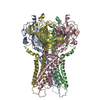
|
|---|---|
| 1 |
|
- Components
Components
| #1: Protein | Mass: 43622.746 Da / Num. of mol.: 4 / Mutation: C166S, G334D Source method: isolated from a genetically manipulated source Source: (gene. exp.)  Homo sapiens (human) / Production host: Homo sapiens (human) / Production host:  Homo sapiens (human) / References: UniProt: B2RC52 Homo sapiens (human) / References: UniProt: B2RC52#2: Chemical | Has ligand of interest | N | Has protein modification | Y | |
|---|
-Experimental details
-Experiment
| Experiment | Method: ELECTRON MICROSCOPY |
|---|---|
| EM experiment | Aggregation state: PARTICLE / 3D reconstruction method: single particle reconstruction |
- Sample preparation
Sample preparation
| Component | Name: Human KATP channel composed of Kir6.2 (C166S G334D) and SUR1 Type: COMPLEX / Entity ID: #1 / Source: RECOMBINANT |
|---|---|
| Molecular weight | Value: 881.87 kDa/nm / Experimental value: NO |
| Source (natural) | Organism:  Homo sapiens (human) Homo sapiens (human) |
| Source (recombinant) | Organism:  Homo sapiens (human) Homo sapiens (human) |
| Buffer solution | pH: 8.5 |
| Specimen | Conc.: 6.83 mg/ml / Embedding applied: NO / Shadowing applied: NO / Staining applied: NO / Vitrification applied: YES |
| Specimen support | Grid material: GOLD / Grid mesh size: 400 divisions/in. / Grid type: Quantifoil R1.2/1.3 |
| Vitrification | Instrument: FEI VITROBOT MARK IV / Cryogen name: ETHANE / Humidity: 100 % / Chamber temperature: 289 K |
- Electron microscopy imaging
Electron microscopy imaging
| Experimental equipment |  Model: Titan Krios / Image courtesy: FEI Company |
|---|---|
| Microscopy | Model: FEI TITAN KRIOS |
| Electron gun | Electron source:  FIELD EMISSION GUN / Accelerating voltage: 300 kV / Illumination mode: FLOOD BEAM FIELD EMISSION GUN / Accelerating voltage: 300 kV / Illumination mode: FLOOD BEAM |
| Electron lens | Mode: BRIGHT FIELD / C2 aperture diameter: 100 µm |
| Image recording | Electron dose: 57 e/Å2 / Detector mode: SUPER-RESOLUTION / Film or detector model: GATAN K2 SUMMIT (4k x 4k) |
- Processing
Processing
| Software | Name: PHENIX / Version: 1.17.1_3660: / Classification: refinement | ||||||||||||||||||||||||
|---|---|---|---|---|---|---|---|---|---|---|---|---|---|---|---|---|---|---|---|---|---|---|---|---|---|
| EM software | Name: PHENIX / Category: model refinement | ||||||||||||||||||||||||
| CTF correction | Type: PHASE FLIPPING AND AMPLITUDE CORRECTION | ||||||||||||||||||||||||
| 3D reconstruction | Resolution: 3.1 Å / Resolution method: FSC 0.143 CUT-OFF / Num. of particles: 151967 / Details: symmetry expanded in C4 / Symmetry type: POINT | ||||||||||||||||||||||||
| Refine LS restraints |
|
 Movie
Movie Controller
Controller











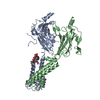
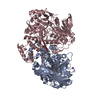
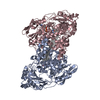
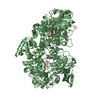

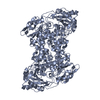
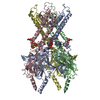
 PDBj
PDBj

